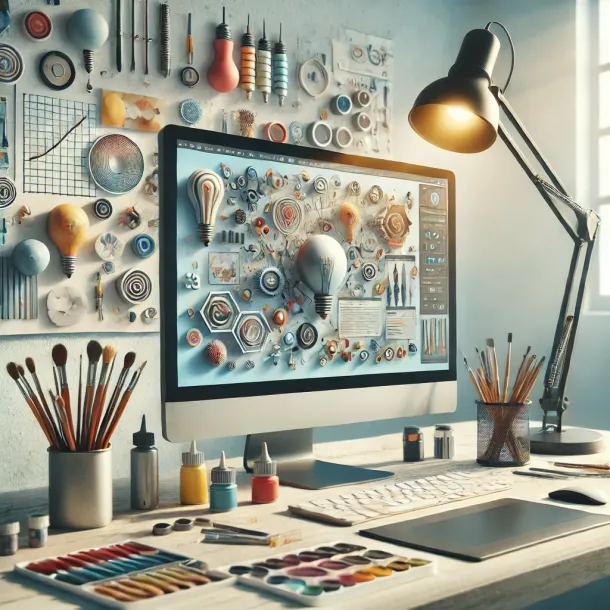The Evolution of Graphic Design: From Print to Digital
The Evolution of Graphic Design: From Print to Digital
Graphic design has undergone a remarkable transformation over the centuries, evolving from traditional print methods to the sophisticated digital techniques we see today. This evolution has been driven by technological advancements, changes in cultural trends, and the growing demand for visually engaging content. In this article, we will explore the history of graphic design, examine the shift from print to digital, and discuss the impact of this transition on the industry.
The Origins of Graphic Design
The roots of graphic design can be traced back to ancient civilizations, where visual communication played a crucial role in conveying messages and preserving information. Early examples of graphic design include cave paintings, hieroglyphics, and illuminated manuscripts. These primitive forms of design laid the foundation for more complex and organized methods of visual communication.
The Invention of the Printing Press
One of the most significant milestones in the history of graphic design was the invention of the printing press by Johannes Gutenberg in the mid-15th century. The printing press revolutionized the way information was disseminated, making it possible to produce books, pamphlets, and other printed materials on a large scale. This innovation not only made information more accessible but also created new opportunities for graphic designers to experiment with typography, layout, and illustration.
With the printing press, the concept of mass communication began to take shape. Graphic designers became instrumental in creating visually appealing and legible layouts for printed materials, including newspapers, posters, and advertisements. The focus during this period was primarily on typography, as the design of typefaces and the arrangement of text were crucial to effective communication.
The Birth of Modern Graphic Design
The late 19th and early 20th centuries saw the emergence of modern graphic design as we know it today. The Industrial Revolution brought about significant changes in society, including the rise of consumerism and the need for effective advertising. As a result, graphic design evolved to meet the demands of a rapidly changing world.
Art movements such as Art Nouveau, Bauhaus, and De Stijl played a significant role in shaping the aesthetics of modern graphic design. These movements emphasized the importance of simplicity, functionality, and the use of geometric shapes in design. The influence of these movements can still be seen in contemporary design practices.
The Transition from Print to Digital
The advent of digital technology in the late 20th century marked a turning point in the field of graphic design. The introduction of personal computers, graphic design software, and the internet revolutionized the way designers worked and communicated with their audiences. The transition from print to digital was not only a technological shift but also a cultural and economic one.
The Rise of Desktop Publishing
The 1980s witnessed the rise of desktop publishing, a technological advancement that allowed designers to create and print their own designs using personal computers. Software programs like Adobe Photoshop, Illustrator, and PageMaker made it possible to manipulate images, create complex layouts, and produce high-quality printed materials from a desktop computer. This democratization of design tools empowered a new generation of designers to experiment with digital techniques and push the boundaries of traditional design.
Desktop publishing also brought about a shift in the role of the graphic designer. No longer confined to the physical limitations of print, designers could now explore new creative possibilities in the digital realm. This period saw the emergence of digital art, a new form of expression that blended traditional design principles with cutting-edge technology.
The Impact of the Internet
The internet’s rapid expansion in the 1990s further accelerated the shift from print to digital. Websites became a primary medium for communication, and graphic designers were tasked with creating visually appealing and user-friendly interfaces. The rise of web design introduced new challenges and opportunities, as designers had to consider factors such as screen resolution, browser compatibility, and user experience.
The internet also transformed the way designers shared and distributed their work. Online portfolios, social media platforms, and digital marketplaces allowed designers to reach a global audience and connect with clients from around the world. This increased accessibility led to a more diverse and dynamic design community, where ideas and trends could be exchanged and adopted at a rapid pace.
The Emergence of Motion Graphics and Interactive Design
As digital technology continued to evolve, so did the scope of graphic design. The early 2000s saw the emergence of motion graphics and interactive design, two areas that pushed the boundaries of traditional static design. Motion graphics, which involve the use of animation and video to convey messages, became increasingly popular in advertising, film, and online media.
Interactive design, on the other hand, focused on creating user-centered experiences through websites, mobile apps, and digital interfaces. This shift towards interactivity required designers to develop new skills and approaches, as they had to consider not only aesthetics but also functionality and usability.
The rise of mobile devices further expanded the role of the graphic designer. Responsive design, which ensures that websites and apps function seamlessly across different screen sizes, became a critical aspect of digital design. As a result, designers had to adapt to new tools and workflows to meet the demands of an increasingly mobile-first world.
The Current State of Graphic Design
Today, graphic design is a multifaceted discipline that encompasses a wide range of practices, from traditional print design to cutting-edge digital experiences. The lines between different design disciplines have blurred, as designers are expected to be versatile and proficient in various tools and techniques.
The Integration of Artificial Intelligence and Automation
One of the most significant trends in contemporary graphic design is the integration of artificial intelligence (AI) and automation. AI-powered tools like Adobe Sensei and Canva are transforming the way designers work by automating repetitive tasks, such as resizing images, generating color palettes, and even creating entire layouts. While some fear that AI could replace human designers, others see it as a valuable tool that can enhance creativity and streamline workflows.
The Role of Design Systems
Design systems have become increasingly important in the digital age, as they provide a standardized framework for creating consistent and scalable designs. Companies like Google, Apple, and IBM have developed comprehensive design systems that guide the creation of user interfaces, ensuring a cohesive and user-friendly experience across their products and platforms.
Design systems also promote collaboration between designers, developers, and other stakeholders, as they provide a shared language and set of guidelines for design projects. This collaborative approach is essential in an industry where speed and efficiency are critical to success.
The Importance of Inclusivity and Accessibility
As graphic design continues to evolve, there is a growing emphasis on inclusivity and accessibility. Designers are increasingly aware of the need to create designs that are accessible to people with disabilities and that cater to diverse audiences. This includes considerations such as color contrast, font readability, and alternative text for images.
Inclusivity also extends to the representation of diverse cultures, identities, and perspectives in design. As the world becomes more interconnected, designers are challenged to create work that resonates with a global audience and reflects the diversity of human experience.
The Future of Graphic Design
The future of graphic design is likely to be shaped by ongoing technological advancements, changing cultural trends, and the increasing demand for personalized and immersive experiences. Here are some potential directions for the field:
Virtual and Augmented Reality
Virtual reality (VR) and augmented reality (AR) are poised to revolutionize the way we interact with digital content. As these technologies become more accessible, graphic designers will need to develop new skills and approaches to create immersive and interactive experiences. This could include designing 3D environments, creating virtual interfaces, and integrating motion graphics with real-world elements.
Sustainability and Ethical Design
As concerns about climate change and social responsibility continue to grow, there is likely to be a greater emphasis on sustainability and ethical design practices. Designers will be tasked with creating work that not only meets the needs of clients and consumers but also aligns with broader social and environmental goals. This could involve using eco-friendly materials, reducing waste, and promoting positive social change through design.
Continued Integration of AI and Machine Learning
AI and machine learning are expected to play an even more significant role in the future of graphic design. As these technologies become more sophisticated, they will likely take on more complex tasks, such as generating design concepts, analyzing user behavior, and optimizing design performance. However, human creativity and intuition will remain essential, as designers will continue to bring their unique perspectives and ideas to the table.
Conclusion
The evolution of graphic design from print to digital has been a remarkable journey, marked by technological advancements, cultural shifts, and the continuous exploration of new creative possibilities. As the field continues to evolve, designers must stay adaptable and open to change, embracing new tools and techniques while remaining grounded in the principles of good design. The future of graphic design holds exciting opportunities, and those who are willing to innovate and push the boundaries will continue to shape the visual landscape for years to come.


